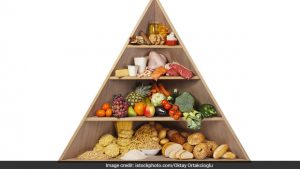 It’s amazing how many different versions there are of healthy food pyramids.
It’s amazing how many different versions there are of healthy food pyramids.
You can find food pyramids on the back of cereal boxes, at school, in diet books, fitness books, and also varying between different countries.
USDA Food Pyramid
The USDA Food pyramid focuses on reducing fats. Serving numbers and sizes vary according to age, sex and activity.
The US Center for Nutrition Policy and Promotion also has US dietary guidelines, last revised 2000. Although by law the guidelines have to be revised every 5 years. The USDA pyramid is often criticised for not distinguishing between different nutritionally good and bad types of fats and grains.
- Group 1: Fats, Oils & Sweets. Use sparingly
- Group 2a: Milk, Yoghurt & Cheese. 2-3 servings.
- Group 2b: Meat, Poultry, Fish, Dry Beans, Eggs & Nuts. 2-3 servings.
- Group 3a: Vegetables. 3-5 servings.
- Group 3b: Fruits. 2-4 servings.
- Group 4: Bread, Cereal, Rice & Pasta. 6-11 servings.
Harvard School of Health Pyramid
The Harvard food pyramid moves away from dairy, red meat, refined starches and towards whole grains, vegetables, plant oils, multi-vitamins, fish, poultry and eggs. Read about it at Harvard Health.
- Group 1a: Red meat, Butter. Use sparingly.
- Group 1b: White rice, white bread, potatoes, pasta, sweets. Use sparingly.
- Group 2: Dairy or Calcium Supplement. 1-2 times/day.
- Group 3: Fish, Poultry, Eggs. 0-2 times/day.
- Group 4: Nuts, Legumes. 1-3 times/day.
- Group 5a: Vegetables. In abundance.
- Group 5b: Fruits. 2-3 times/day.
- Group 6a: Whole Grain Foods. At most meals.
- Group 6b: Plant oils, including olive, canola, soy, corn, sunflower, peanut.
And of course, daily exercise and weight control.
They do allow alcohol in moderation, unless contraindicated. And distinguishes whole grains and good fats from processed grains and fats. I like this one.
Australian Food Pyramid and Guidelines
Nutrition Australia is a non-government organisation, that produces the most well-known Australian Food Pyramid – the Healthy Eating Pyramid. It is similar to the USDA Food Pyramid in the simplistic grouping of all fats together, although it gives equal ranking to Fruits, Vegetables, Grains and Cereals.
The Australian Government Department of Health National Health and Medical Research Council has provided the official Dietary Guidelines for Australians. Not presented as a pyramid, the main points are:
Enjoy a wide variety of nutritious foods:
- Eat plenty of vegetables, legumes and fruits
- Eat plenty of cereals, preferable wholegrain
- Include lean meat, fish, poultry and/or alternatives
- Include milks, yoghurts and cheeses, reduced fat where possible
and take care to:
- Limit saturated fat and moderate total fat intake
- Choose foods low in salt
- Limit your alcohol intake
- Consume only moderate amounts of sugars
Be physically active
Care your food: prepare and store it safely.
The Okinawa Food Pyramid
The residents of Okinawa are famously healthy, long-lived, with a higher percentage of 100-year-olds than anywhere else. Heart disease, strokes and cancer are rare and even the elderly have impressively sharp minds.
The Okinawa Food Pyramid emphasizes eating healthy calcium, flavonoid and omega-3 rich foods. Whole grains and vegetables make up the base of the pyramid. A reduced calorie intake is also a large reason for success.
- Group 1: Sweets. 0-3 servings weekly.
- Group 2: Meat, poultry and Eggs. 0-7 weekly.
- Group 3: Vegetable Oils and Condiments. Sparingly.
- Group 4: Omega-3 Foods (Fish, Nuts). 1-3 servings daily.
- Group 5a: Fruit. 2-4 servings daily.
- Group 5b: Flavonoids. 2-4 servings daily.
- Group 5c: Calcium Foods. 2-4 servings daily.
- Group 6a: Rice, Noodles, Beans, Whole Grain. 7-13 servings daily.
- Group 6b: Vegetables. 7-13 servings daily.